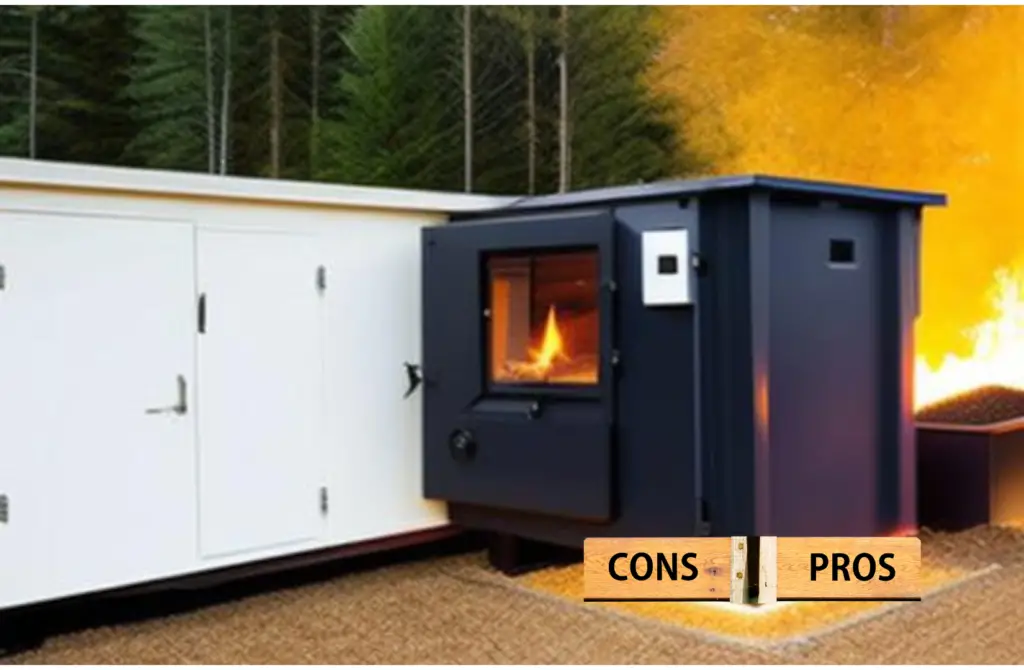Biomass energy has once again become a popular energy source after its fall in the mid-1800s. Recent studies have shown that biomass can replace the use of fossil fuels used for cooking, heating, and driving machines.
Biomass is derived from plant and animal waste. Energy is generated from biomass either by direct combustion or from the liquid and gaseous fuels gotten from biomass. Residential homes use the combustion of wood (pellets, chips, logs) in their boilers or stoves for central heating and hot water.
The use of biomass is gradually increasing, especially in countries like the United Kingdom and the United States. Biomass makes up about 12% of the UK’s renewable energy. While it is about 5% of the United state’s energy generated. Biomass energy has a host of underlying benefits, some of which we will consider below. Also, we will consider the various forms of Biomass energy. Keep Reading!

Various forms of Biomass Energy
l Burning
This is the most common and simplest means of generating energy from Biomass. Wood burning is the simplest form of extracting heat under this process. A simple campfire or a fireplace in homes can be classified as a form of Biomass Energy.
Also, this form of energy is used to drive electrical turbines for electrical energy. The biomass is burnt in a boiler to produce high-pressure steam. This high-pressure steam is used to turn the turbine, which subsequently powers the generator for electricity. Biomass is usually co-fired with coal in coal power plants. This helps to reduce the amount of Greenhouse gases emitted and eases the demand for coal.
l Bacteria Decomposition
This process is also known as Anaerobic Digestion. Here, biomass such as animal dung and other forms of human waste is collected and stored in tanks called digesters. These tanks are oxygen-free hence the term anaerobic.
In the absence of oxygen, bacteria begin to act on the waste collected and convert the biomass to ethanol, methanol, and other forms of biofuel. These biofuels are then collected, purified, and used for various systems. For example, the ethanol collected is used as fuel for vehicles, and the renewable gases(biogas/bio-methane) collected can easily be substituted for machines that run on fossil gases.
l Thermochemical Conversion
Under this process, Biomass is converted to various liquid or gaseous fuels under high temperatures. This is achieved using the following processes:
- Pyrolysis: This is the practice of heating Biomass in the absence of oxygen between 200-300C. The absence of oxygen in this process ensures that the biomass materials do not combust and alter their molecular structure. This process produces a compound known as Bio-Oil or Pyrolysis oil, Biochar(a form of charcoal), Methane, and Hydrogen

The materials gotten from this process can be easily substituted or used along with conventional fuels. For example, pyrolysis oil is easily combusted and used to drive turbines, engines, and furnaces. Also, the methane generated here is a close substitute for natural gas. The Biochar obtained is mainly used for agriculture. It nourishes the soil and prevents leaching in the soil.
- Gasification
Here, the biomass is heated above 700° C with very little or a controlled amount of oxygen. After the heating process, the final products are Syngas(synthesis gas) and Slag.
Syngas is a combination of CO and Hydrogen. The syngas collected is purified and can now be burnt in boilers to generate electricity in gas power plants. It can also serve as fuel for diesel engines or be burnt directly to generate heat.
Also, this syngas can be further broken down to separate the hydrogen from the carbon monoxide. This hydrogen is very pure and is used to power and fuel automobiles. Slag is a molten, glassy liquid. It is used to produce asphalt and cement

How do Residential Biomass Systems Work?
Biomass heating systems work in the same manner as conventional boilers. They work on the principle of direct combustion. In this case, the biomass is combusted as opposed to the fossil fuel used in conventional boilers.
The heat generated from this combustion process travels through a flue and passes through a heat-exchanger. This transfers the heat either to the house’s central heating or to a buffer tank to boil water. The output of the biomass boiler is easily incorporated with an underfloor heating system or a radiator.
The biomass used here is usually in the form of wood logs, wood pellets, or wood chips. As a result of this, they are usually very large. This is because the volume of the biomass is very large compared to conventional biomass that makes use of fuels or gas. Also, the homeowner would need to have storage space for the biomass, to aid easy access and proper safekeeping. The biomass is fed into the boiler either manually or automatically.
Types of Residential Biomass Heating systems
There are majorly two types/forms of residential biomass heating systems. They are as follows:
- Stoves
They make use of logs or wood pellets as fuel for heating. Stoves are more suited to heating individual rooms. Also, stoves can be fitted with boilers or other heating systems to heat water for bathrooms and kitchens. They have an efficiency of between 60-80% and maximum heat output of 7KW.
- Boilers
Boilers are larger and more refined to suit your home’s central heating and hot water. They make use of logs, wood pellets, wood chips, or even sawdust as fuel. There are some variations of boilers that make use of combinations of different wood fuels.
Log Boilers have an energy output of between 20-50KW, while pellet and chip boilers have a maximum output of 30 and 50+KW respectively. Pellet Boilers usually incorporate a hopper that helps feed the boiler automatically without human assistance, unlike Log Boilers.
Biomass vs Biofuel
Biomass refers to all materials gotten from plants and animals. They include animal dung, plants, forest residues, vegetable oil, animal oils, wood pulp, and so on. These materials are easily accessible and exist in free form. They have less environmental impact compared to fossil fuels. The energy from these biomass materials is then used for cooking, electricity, and central heating.
Biofuels are simply products derived from the processing or conversion of biomass. Biofuels are renewable energy sources. Biofuels are a close substitute to fossil fuels, used to run machines and vehicles. These product offer clean emissions compared to fossil fuels. Biofuels are usually in liquid or gas form. They include ethanol, biodiesel, butanol, Bio-oil, ethanol, and so on.

Benefits of Biomass in Heating systems
The following are the reasons why Biomass heating systems are a viable heating means:
- Biomass is Renewable
Biomass is considered renewable because its source can be replenished. Trees and Animal waste will always be available if sustainable methods of collection are used. This is only possible if there is a conscious effort made by each individual in the environment. This fuel source has a tendency to replace traditional fossil fuel sources and that is key.
- Biomass Heating is affordable and easily accessible
Compared to fossil fuels, Biomass generates greater savings on energy. The cost of a Biomass boiler is between £3000-£11500 depending on its size. Also, Biomass boilers are eligible for Renewable Heat Incentives. This also subsidizes the initial cost of these systems. The table below shows the cost of Biomass to fuel boilers compared to other fuel types.
| Fuel Type | Cost per Unit | Kwh per unit generated | Pence per Kwhr |
| Wood Chips | £100 per tonne | 3500Kwhr /tonne | 2.9p/kWh |
| Wood Pellets | £200 per tonne | 4800Kwhr/tonne | 4.2p/kWh |
| Natural gas | 4.8Kw/hr | 1 | 4.8p/kWh |
| Heating Oil | 60p per liter | 10Kw/liter | 6.0p/kWh |
While the prices of traditional fuel are on the rise, Biomass is still somewhat stable. Therefore, to combat the gradual increase in the cost of heating with fossil fuels, biomass is a viable alternative.
- Biomass heaters are Efficient
On average, Biomass heating systems have an efficiency of between 80-90% while in operation. Although this is subject to the house’s insulation and the size of the boiler relative to the space heated. Biomass heating systems are a better alternative to fossil fuel heaters. Wood pellets ensure better heating efficiency compared to logs and wood chips.

Cons of Biomass Heating Systems
The following are the drawbacks of Biomass Heating systems:
- They require a lot of space
This is a result of the space needed to burn the biomass in the boiler. Also, the homeowner would need space to store the biomass.
- It requires human presence
Regardless of how automated the boiler system may seem, it requires the presence of someone to regulate the heating process. The heating system would need to be refueled from time to time, depending on the size of the Boiler. Also, the ash buildup would need to be cleaned from time to time.
- Some areas may require permits before they can be installed
Biomass and the Environment
Biomass is classified as a clean source of energy. Although, this is not completely true, since there are still carbon emissions generated when the biomass is burnt. Instead, it is better classified as Carbon-neutral. This is because the carbon emitted when the biomass is burnt is canceled out by the amount of carbon absorbed by the plant during photosynthesis. This phenomenon continues to be in balance as long as plants and trees are grown. Else, it could also lead to deforestation.
Is Biomass Heating safe?
Biomass heating is completely safe as long as the system is well designed and installed. Also, ensure there is enough ventilation in the house while the system is in operation. This is to prevent carbon monoxide poisoning. Also, for total protection, the homeowner can install carbon monoxide detectors around the house.
Final Thoughts
Biomass heating systems present several benefits as opposed to their fossil fuel counterparts. Biomass is renewable, easily accessible, and carbon-neutral. They also qualify for Renewable Heat Incentives, which help subsidize the cost of the system.
The use of biomass heating systems or biomass materials in machines will help cut down carbon emissions by 60% as long trees are continuously planted. This makes a huge case for Biomass materials as manufacturers tend to achieve a net-zero carbon environment.
